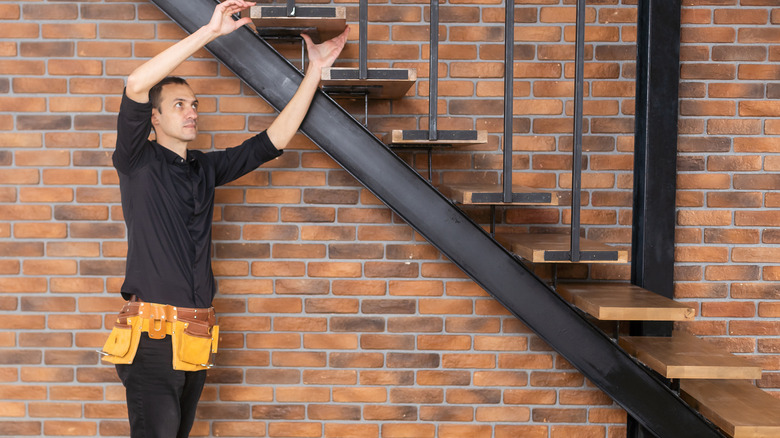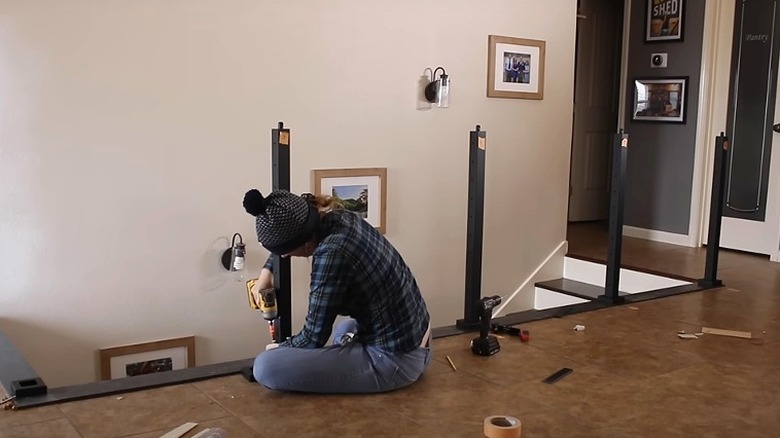TikTok's Open And Modern Stairwell DIY Might Inspire One Of Your Own
When you're dreaming up your ideal home or diving into a renovation, it's easy to get excited about designing kitchens and bedrooms. But often, the staircase gets overlooked. Yet this everyday feature can dramatically shape the look and feel of your home. For instance, you may want to convert your stair's half walls (which makes the space feel too enclosed) and open the entire area by remodeling it with a more modern, sleek design. However, taking on a stairway DIY might feel like a daunting endeavor — after all, DIYing a stairway is a significant overhaul that needs thoughtful planning and a good dose of hard work. If you need some encouragement, look at TikTok user jonelllovesDIY, who, with the help of her husband, completely transformed their stairway by tearing down their pony walls and replacing them with a cable rail system.
You can do a staircase makeover on a budget without getting overwhelmed by planning and picking your battles. There's plenty of room to tailor a stairway DIY to your skill level and comfort zone. For instance, jonellelovesDIY purchased a made-to-order (MTO) cable rail kit and stair supplies for effortless application. With renovations costing an average of $2,300 but going as high as $30,000, you can cut down significantly on expenses while enjoying the journey of creation when you take the DIY route!
Considerations before you do your stairwell DIY
Before you embark on your DIY project, it's wise to sit down and think of your "why" for remodeling your stairs. Are you aiming to rejuvenate your home's ambiance, or is it time to update your staircase and say goodbye to your outdated, carpeted one? Understanding your motivations will guide your design choices. Note that the complexity of your renovation depends on the existing staircase style and the one you envision. For example, jonellelovesDIY's journey from closed stringer stairs to an open concept with exposed treads and cable railings was undoubtedly more complex than a simple tread color change.
Next, focus on the specifics: think banister and railing designs, materials, and color schemes. Then, decide which parts of the project you'll handle and which you'll leave to the professionals. If you're considering MTO systems and supplies, now is an excellent time to seek referrals or scour the internet for suppliers. List the materials and tools you'll need for the DIY aspects. Regardless of how much you choose to DIY or outsource to experts, getting precise measurements of every stairway element — from treads and risers to the angle of your base rail — is crucial. This ensures you get exactly what you need for a successful stairway makeover.
How to do an open and modern stairwell DIY
Before demolishing your old stairwell, turn off the power and move any electrical wiring or switches. Remove the drywall using a saw or oscillating tool, then reinforce the framing for baluster or railing support. The following steps depend on your staircase design and vision. For instance, YouTuber Mr. Build It created an angled frame by the treads for steel railings, hiding the treads, while jonellelovesDIY made frames level with the treads for visible post installation. For the top board to lay on top of your frame, cut MDF boards to size, like YouTube DIYer April Wilkerson and Mr. Build It did.
Updating your stair treads is easier than you think; standard stairs can use pre-made treads with nosing. Opt for flooring and square nose trims for landings and stairs with open sides. Measure and cut these to fit, then dry-fit them. Secure with construction adhesive, applied in an S or zigzag pattern using a caulking gun. Regarding railings, consider an MTO cable rail system similar to what jonellelovesdiy used. These kits come with all necessary hardware, requiring only assembly with tools like drills and a level. Start by installing the posts, followed by the handrails, and finish with the cables. Alternatively, DIY this process and make your own newel post, handrails, and balusters. Or, buy them from a home improvement store and install them yourself. Remember to check your local stair railing codes, which cover specifics like baluster spacing and height.

